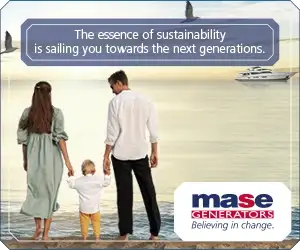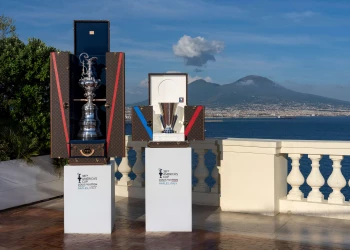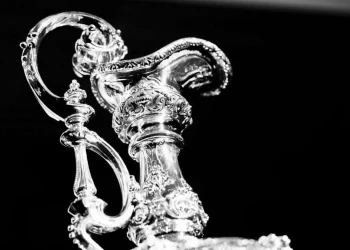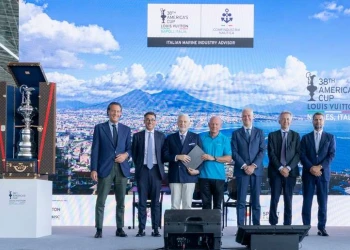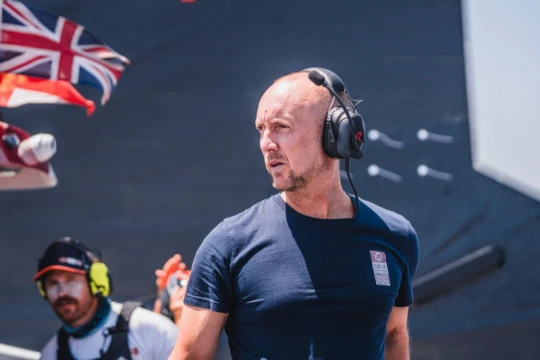
Ineos Britannia's Rob Wilson ahead of the Preliminary Regatta
Ineos Britannia's Rob Wilson ahead of the Preliminary Regatta
For all the teams in the Louis Vuitton 37th America’s Cup, arguably one of the key roles is that of the coaches who provide a vital link between the sailors and the rest of the team with an all-encompassing vision that allows for outright focus to produce the best on-the-water performance. Every team has employed elite-level coaches and for INEOS Britannia, the Challenger of Record, they have the deep-experience of Rob Wilson, now in his third America’s Cup campaign with the British team.
Often un-heralded to the outside, the coaches are absolutely integral to the sailors, analysing performance, advising, eking out gains, talking through tactics and spotting differentials as well as being the ultimate sounding-board for ideation and innovation. It’s a tough role where trust is at the very heart of the relationship and it’s something that Rob has cultivated with Sir Ben Ainslie since their early career sailing Optimists in the National Youth Squads of Jim Saltonstall.
Highly respected in world yachting, Rob very much sees a duel role split between performance and race-craft, saying: “It’s always such a balancing act in the lead up because you can see performance in terms of pure boatspeed always on the water, and it’s a race against time and I think it’s how you balance your time to eke out those extra performance gains versus doing your start practice, your tactics, your comms practice and all that side of it, contesting the course etc. At the moment we are still treading that line, I would say we’re putting a little more time in on the performance side, but we also use the SIM in the background to do a lot of the race skills, so it doesn’t take the whole team’s resources to do that. For sure it’s a balancing act and I’m sure all the teams will be treading that line.”
Looking ahead to the final Preliminary Regatta that kicks off in Barcelona on the 22nd August 2024, Rob has been doing homework on the competition and can see a variation of approach to racing certain teams when required: “All the teams out there are super-tight at the moment and we’ve still got time for teams to make bigger steps so I guess there may be a slight difference in strategy if you feel like you are racing a team that is particularly strong in certain conditions because sea state especially, and of course wind speed, is going to suit certain teams more than others so I think you have to adjust how you approach those races depending on their strengths and weaknesses.”
INEOS Britannia’s stunning AC75, bristling with innovation and design features throughout is looking to be a strong contender in the Louis Vuitton Cup and Rob’s take on how the conditions could affect performance is interesting: “It’s been at the forefront of the design teams and the sailor’s minds since the venue was announced and dealing with the sea-state is going to be a part of that. But it’s a balancing act as well because you’ve just got to look at the percentage of windy days, wavy days, it’s generally lighter, you do get super wavy days but you also get quite a few days when it’s a smaller chop so everyone’s positioned their boats in slightly different areas so you will get boats performing slightly better relative to their own targets in set conditions. Generally, on the wavy side you give up a little bit of performance for usability, quite a generalisation but I’d say that probably holds true, and some teams have been more aggressive on things for example like bustle clearance which then makes it tougher in the sea state but aerodynamically they should get a gain in the lighter winds.”
As we saw in the Preliminary Regattas in Vilanova i La Geltrú and Jeddah, Saudi Arabia, technique in the much smaller AC40 was everything, with racing being decided on pure tacking and gybing manoeuvre execution. In the super-powerful AC75 it is clearly an area that all the teams have been working on and the British are no different as Rob confirms: “The technique for the tacks and gybes is massive because you are spending a big proportion of a race re-accelerating but equally if you have a fast, efficient boat then that re-acceleration is generally easier but there’s also a balance between acceleration and top-end speed. It’s key, you look at the number of tacks and gybes the boats are doing in the race and it’s a big time-loss or gain depending on who you are against.”
From a coaching perspective, what realistically can be done if there’s a performance deficiency? It’s a question that will be asked of all the coaches at some stage during the upcoming regattas and Rob’s take on it is one of calm and process, saying: “If you are lacking speed or performance in a manoeuvre, if it is technique based, then you can make a pretty big change quite quickly. On the performance side, depending where it is, it takes time with these boats, they’re big bits of kit so it takes time to move things forward, but if it’s purely in your settings then you can change it quite quick but if it’s fundamental equipment then it can be quite long lead times but for sure there’s room to make gains and losses.”
Plenty of time has been spent both on the water and in race simulation off the water, concentrating on pre-starts and in practice we’ve seen all the teams really pushing this area with the expectation that performance on the race-track will be quite even. Getting an advantage here is key and Rob sees it simply: “Depending on which team you are looking at, good is you are winning the start, and you are able to go in the direction that you want to and you’re able to go to the side of the course that you want to, I think that’s a winning pre-start.”
After three years of build-up for the British and a huge amount of effort from the whole team, the final Preliminary Regatta in Barcelona is something they are all looking forward to getting stuck into. Rob’s enthusiasm for the racing is infectious: “I love it when we get racing, I think that’s why we all do it, we love the racing side. The Cup is a funny one because it’s such a big build-up of the equipment side, but a lot of people are doing other circuits to keep race sharp, so we haven’t missed that at all, but we are all excited to get on the track and race these big boats I think it’s going to be quite a show especially here in Barcelona along this seafront, it’s going to be amazing.”
Racing for the final Preliminary Regatta starts on the 22nd August and runs through to the 25th August; for INEOS Britannia it is the perfect chance to gauge exactly where they are ahead of the Louis Vuitton Cup and for Rob Wilson, the day-job really gets interesting.


